Feature Papers in Membrane Processing and Engineering
Share This Topical Collection
Editor
Topical Collection Information
Dear Colleagues,
The scope for the Topic Collection includes but is not limited to the following: Fundamentals of process modeling and technoeconomic assessment; New concepts in hybrid processes and process integration; Innovations in module modeling and design; Advances in real-time process monitoring, control, and automation; Fundamentals of predicting and preventing membrane fouling; Innovations in MF and UF; Case studies in process scale-up; Membrane distillation and pervaporation: innovations in process design and scalability; Process innovations in electrofunctional and electrocatalytic membrane processes; New concepts in osmotically-driven membrane processes.
Dr. Jia Wei Chew
Collection Editor
Manuscript Submission Information
Manuscripts should be submitted online at www.mdpi.com by registering and logging in to this website. Once you are registered, click here to go to the submission form. Manuscripts can be submitted until the deadline. All submissions that pass pre-check are peer-reviewed. Accepted papers will be published continuously in the journal (as soon as accepted) and will be listed together on the collection website. Research articles, review articles as well as short communications are invited. For planned papers, a title and short abstract (about 100 words) can be sent to the Editorial Office for announcement on this website.
Submitted manuscripts should not have been published previously, nor be under consideration for publication elsewhere (except conference proceedings papers). All manuscripts are thoroughly refereed through a single-blind peer-review process. A guide for authors and other relevant information for submission of manuscripts is available on the Instructions for Authors page. Membranes is an international peer-reviewed open access monthly journal published by MDPI.
Please visit the Instructions for Authors page before submitting a manuscript.
The Article Processing Charge (APC) for publication in this open access journal is 2700 CHF (Swiss Francs).
Submitted papers should be well formatted and use good English. Authors may use MDPI's
English editing service prior to publication or during author revisions.
Published Papers (2 papers)
Open AccessReview
Recent Advances and Challenges in Anion Exchange Membranes Development/Application for Water Electrolysis: A Review
by
Lu Liu, Hongyang Ma, Madani Khan and Benjamin S. Hsiao
Viewed by 626
Abstract
In recent years, anion exchange membranes (AEMs) have aroused widespread interest in hydrogen production via water electrolysis using renewable energy sources. The two current commercial low-temperature water electrolysis technologies used are alkaline water electrolysis (AWE) and proton exchange membrane (PEM) water electrolysis. The
[...] Read more.
In recent years, anion exchange membranes (AEMs) have aroused widespread interest in hydrogen production via water electrolysis using renewable energy sources. The two current commercial low-temperature water electrolysis technologies used are alkaline water electrolysis (AWE) and proton exchange membrane (PEM) water electrolysis. The AWE technology exhibited the advantages of high stability and increased cost-effectiveness with low hydrogen production efficiency. In contrast, PEM water electrolysis exhibited high hydrogen efficiency with low stability and cost-effectiveness, respectively. Unfortunately, the major challenges that AEMs, as well as the corresponding ion transportation membranes, including alkaline hydrogen separator and proton exchange membranes, still face are hydrogen production efficiency, long-term stability, and cost-effectiveness under working conditions, which exhibited critical issues that need to be addressed as a top priority. This review comprehensively presented research progress on AEMs in recent years, providing a thorough understanding of academic studies and industrial applications. It focused on analyzing the chemical structure of polymers and the performance of AEMs and established the relationship between the structure and efficiency of the membranes. This review aimed to identify approaches for improving AEM ion conductivity and alkaline stability. Additionally, future research directions for the commercialization of anion exchange membranes were discussed based on the analysis and assessment of the current applications of AEMs in patents.
Full article
►▼
Show Figures
Open AccessReview
Electro-Driven Materials and Processes for Lithium Recovery—A Review
by
Anna Siekierka, Marek Bryjak, Amir Razmjou, Wojciech Kujawski, Aleksandar N. Nikoloski and Ludovic F. Dumée
Cited by 12 | Viewed by 5031
Abstract
The mass production of lithium-ion batteries and lithium-rich e-products that are required for electric vehicles, energy storage devices, and cloud-connected electronics is driving an unprecedented demand for lithium resources. Current lithium production technologies, in which extraction and purification are typically achieved by hydrometallurgical
[...] Read more.
The mass production of lithium-ion batteries and lithium-rich e-products that are required for electric vehicles, energy storage devices, and cloud-connected electronics is driving an unprecedented demand for lithium resources. Current lithium production technologies, in which extraction and purification are typically achieved by hydrometallurgical routes, possess strong environmental impact but are also energy-intensive and require extensive operational capabilities. The emergence of selective membrane materials and associated electro-processes offers an avenue to reduce these energy and cost penalties and create more sustainable lithium production approaches. In this review, lithium recovery technologies are discussed considering the origin of the lithium, which can be primary sources such as minerals and brines or e-waste sources generated from recycling of batteries and other e-products. The relevance of electro-membrane processes for selective lithium recovery is discussed as well as the potential and shortfalls of current electro-membrane methods.
Full article
►▼
Show Figures








